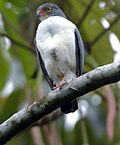Leucopternis
| Leucopternis | |
|---|---|

| |
| Semiplumbeous hawk (Leucopternis semiplumbeus) | |
| Scientific classification | |
| Domain: | Eukaryota |
| Kingdom: | Animalia |
| Phylum: | Chordata |
| Class: | Aves |
| Order: | Accipitriformes |
| Family: | Accipitridae |
| Subfamily: | Buteoninae |
| Genus: | Leucopternis Kaup, 1847 |
| Type species | |
| Falco melanops[1] Latham, 1790
| |
Leucopternis is a Neotropical genus of birds of prey in the family Accipitridae. They are associated with tropical forest, and are uncommon or rare. Their plumage is largely black or gray above and white below, and they have distinctive orange ceres.
Species
Traditionally, Leucopternis contains significantly more species than given here. However, as the genus probably was polyphyletic,[2] moves of species to other genera were proposed[3] and have been accepted by the American Ornithologists' Union's South American Check-list Committee[4] and North American Check-list Committee,[5] except that the South American Committee placed the former L. lacernulatus in the existing genus Buteogallus instead of in a new genus Amadonastur by itself. The other species were placed in the genera Cryptoleucopteryx, Morphnarchus, Pseudastur, and Buteogallus. According to this treatment, the species remaining in Leucopternis are:
| Image | Scientific name | Common Name | Distribution |
|---|---|---|---|
 |
Leucopternis semiplumbeus | Semiplumbeous hawk | Colombia, Costa Rica, Ecuador, Honduras, and Panama |
 |
Leucopternis melanops | Black-faced hawk | lowland Peru north of the Amazon and northeastern Ecuador to Venezuela, southern Colombia, Brazil north of the Amazon and the Guyanas. |
 |
Leucopternis kuhli | White-browed hawk | southern Amazon Basin in eastern Peru, Bolivia and northern Brazil. |
Notes
References
- Chesser, R. Terry; et al. (2012). "Fifty-third Supplement to the American Ornithologists' Union Check-list of North American Birds" (PDF). The Auk. 129 (3): 573–588. doi:10.1525/auk.2012.129.3.573. S2CID 198159113. Retrieved 2012-07-18.
- Lerner & Mindell (2008). Molecular phylogenetics of the buteonine birds of prey (Accipitridae). Auk 125: 304–315.
- Raposo do Amaral, Miller, Silveira, Bermingham, & Wajntal (2006). Polyphyly of the hawk genera Leucopternis and Buteogallus (Aves, Accipitridae): multiple habitat shifts during the Neotropical buteonine diversification. BMC Evol. Biol. 6: 10
- Raposo do Amaral, F. S.; et al. (2009). "Patterns and Processes of Diversification in a Widespread and Ecologically Diverse Avian Group, the Buteonine Hawks (Aves, Accipitridae)". Molecular Phylogenetics and Evolution. 53 (3): 703–715. doi:10.1016/j.ympev.2009.07.020. PMID 19635577.
- Remsen, J. V. Jr.; et al. "A Classification of the Bird Species of South America". American Ornithologists' Union. Archived from the original on 2009-03-02. Retrieved 2012-07-18.



